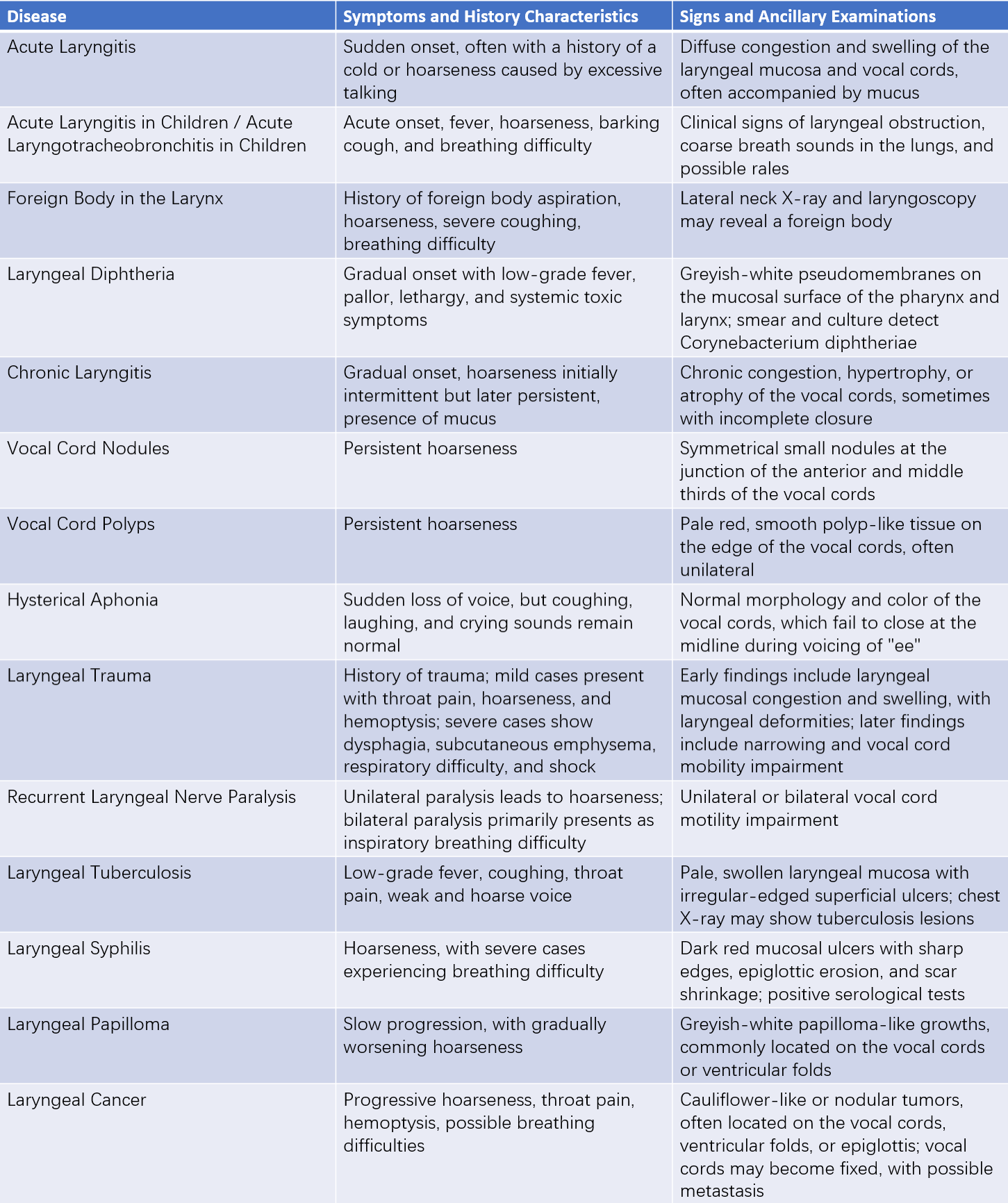Chronic laryngitis refers to chronic nonspecific inflammation of the larynx. Clinically, it is categorized into chronic simple laryngitis, hypertrophic laryngitis, and atrophic laryngitis.
Etiology
The exact cause of chronic laryngitis is not clearly understood, but several contributing factors are recognized:
Vocal Overuse
This is frequently observed in individuals who habitually overuse their voice, such as teachers or sales personnel.
Prolonged Exposure to Harmful Gases or Dust
This is common among long-term smokers or those working in dusty environments.
Chronic Inflammation of the Nasal Cavity, Paranasal Sinuses, or Pharynx
Inflammation in these areas can directly extend to the larynx. Nasal obstruction can also lead to mouth breathing, where unfiltered air stimulates the mucosa of the larynx over time.
Recurrent or Prolonged Acute Laryngitis
Repeated episodes or persistent cases of acute laryngitis can contribute to chronic laryngitis.
Chronic Inflammation of the Lower Respiratory Tract
Chronic coughing and persistent exposure to purulent secretions can irritate the laryngeal mucosa.
Gastroesophageal Reflux Disease (GERD)
Long-term reflux of stomach contents into the esophagus can lead to chronic irritation of the laryngeal mucosa.
Pathology
The condition is primarily characterized by dilation and congestion of laryngeal mucosal capillaries, lymphocyte infiltration, interstitial edema, and increased mucus gland secretions. Some patients exhibit fibrous tissue hyperplasia, resulting in mucosal thickening. In rare cases, the laryngeal mucosa undergoes atrophy, with the columnar ciliated epithelium transforming into squamous epithelium and the glands also atrophying.
Clinical Manifestations
Hoarseness
Hoarseness is the primary symptom of chronic laryngitis and may range in severity. Some patients experience normal voice in the morning but develop hoarseness after prolonged speaking. Others may find hoarseness worse in the morning, which improves after talking for a while or coughing out secretions. Most patients experience symptom relief after a period of voice rest, though recurrence occurs with excessive voice use.
Throat Discomfort
Symptoms include a dry sensation, a foreign body sensation, or discomfort such as throat pain.
Increased Secretions
Some patients exhibit an increase in laryngeal secretions, forming sticky mucus that interferes with speaking and often requires coughing up the mucus for relief.
Examination
Chronic Simple Laryngitis
The laryngeal mucosa appears diffusely congested, sometimes with mild swelling. The vocal cords may appear pink with blunted edges. Secretions are occasionally visible on the surface of the vocal cords, forming mucus filaments between both vocal cord edges.
Hypertrophic Laryngitis
Hypertrophy is often seen in the ventricular folds (false vocal cords), sometimes obscuring parts of the true vocal cords, or causing the anterior ends of the ventricular folds on both sides to meet, making the anterior part of the vocal cords invisible on indirect laryngoscopy. The edges of the vocal cords appear blunted and thickened, with severe cases showing anterior portions of the vocal cords meeting each other, preventing the glottis from fully opening.
Atrophic Laryngitis
The laryngeal mucosa becomes thin and dry, with severe cases showing crust formation on the mucosal surface. During glottal closure, a spindle-shaped gap may be observed.
Diagnosis
Diagnosis is typically straightforward based on the history of prolonged hoarseness and findings from laryngoscopic examination. However, as numerous laryngeal conditions can cause hoarseness, proper differentiation from other diseases is necessary.

Table 1 Key points in the differential diagnosis of hoarseness
Treatment
Addressing the Underlying Cause
Contributing factors, such as excessive voice use, smoking, and alcohol consumption, are addressed. Work environments should be improved, and individuals working in dusty conditions should adopt enhanced protective measures. Chronic inflammation of the nasal cavity and paranasal sinuses is actively treated, as well as nasal obstruction, nasal discharge, pharyngeal infections, lower respiratory tract infections, and gastroesophageal reflux disease.
Nebulized Therapy
Medications can be delivered via nebulization. Commonly used nebulized solutions include budesonide suspension.